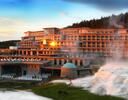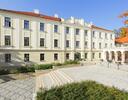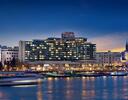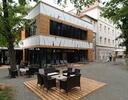Best of Hungary
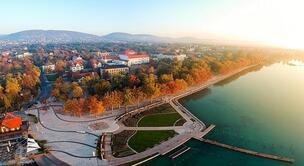
Stunning architecture, vital folk art, thermal spas and Europe's most exciting capital after dark are Hungary's major drawing cards.
Super Structures
Hungary’s scenery is more gentle than striking. But you can’t say the same thing about the built environment across the land. Architecturally Hungary is a treasure trove, with everything from Roman ruins and medieval townhouses to baroque churches, neoclassical public buildings and art nouveau bathhouses and schools. And we're not just talking about its capital, Budapest. Walk through Szeged or Kecskemet, Debrecen or Sopron and you’ll discover an architectural gem at virtually every turn. Indeed, some people go out of their way for another glimpse of their favourites, such as the Reok Palace in Szeged or the Mosque Church in Pecs.
In Hot Water
Hungarians have been 'taking the waters' supplied by an estimated 300 thermal springs since togas were all the rage and Aquincum was the Big Smoke. They still do – for therapeutic, medicinal and recreational purposes – but the venues have changed somewhat. Today they range from authentic bathhouses dating from the Turkish occupation and art nouveau palaces to clinical sanatoriums straight out of a Thomas Mann novel. More and more though, you'll see clear chlorinated waters in organically shaped pools that bubble, squirt and spurt at different rhythms and temperatures alongside requisite wellness centres offering a myriad of treatments.
Eat, Drink & Be Magyar
Hungarian food remains the most sophisticated style of cooking in Eastern Europe. Magyars even go so far as to say there are three essential world cuisines: French, Chinese and their own. That may be a bit of an exaggeration, but Hungary's reputation as a food centre dates largely from the late 19th century and the first half of the 20th and, despite a fallow period under communism, their cuisine is once again commanding attention.
Folk Culture
Hungary has one of the richest folk traditions still alive in Europe. With exquisite folk paintings found on the walls and ceilings of the tiny wooden churches of the Bereg region and the wonderful embroidery that the women of Hollókő stitch to decorate smocks, skirts and slippers, this is often where the country comes to the fore artistically.
Itinerary
- Day 1
Arrival Budapest
Arrival Budapest airport, meet & greet by our representative, Transfer to hotel / apartment for check in
Budapest has something for everyone – from dramatic history and flamboyant architecture to healing thermal waters and a nightlife that is unrivalled in Eastern and Central Europe.
The Human Touch
Budapest’s beauty is not all God given; humankind has played a role in shaping this pretty face too. Architecturally, the city is a treasure trove, with enough baroque, neoclassical, Eclectic and art nouveau buildings to satisfy everyone. Overall, though, Budapest has a fin de siècle feel to it, for it was then, during the capital’s ‘golden age' in the late 19th century, that most of what you see today was built.
The Past at Hand
They say the past is another country, but it’s always been just around the corner in Budapest. Witness the bullet holes and shrapnel pockmarks on buildings from WWII and the 1956 Uprising. There are sad reminders like the poignant Shoes on the Danube memorial, but ones, too, of hope and reconciliation – like the 'sword' of the former secret-police building on Andrássy út now beaten into the 'ploughshare' that is the House of Terror, with both sides of the story – left and right – told.
In the Soak
Budapest is blessed with an abundance of hot springs. As a result, ‘taking the waters’ has been an experience here since the time of the Romans. The array of bathhouses is generous – you can choose from Turkish-era, art nouveau and modern establishments. Some people come seeking a cure for whatever ails them, but the majority are there for fun and relaxation – though we still maintain it’s the world’s best cure for what Hungarians call a macskajaj (cat’s wail) – hangover.
Day at leisure to explore Budapest on your own
Overnight at Budapest - Day 2
Budapest / Local sightseeing
Today embark on a sightseeing trip of Budapest
Fisherman's Bastion
The seven fairy tale-like towers of Fisherman's Bastion offer views of the Danube and Pest side of the city. Built in the late 19th century and restored after World War II, this Neo-Gothic and Neo-Romanesque structure within World Heritage Site Buda Castle takes its name from the medieval fisherman who defended these city walls. On the Buda side of the city, walk up or take a funicular to the top of Castle Hill to get to the bastion, near the 14th-century Matthias Church. Step inside one of the seven towers for spectacular views across the Danube River.
Matthias Church
At Matthias Church--within World Heritage Site Buda Castle--admire an eclectic fusion of architectural styles. Originally built in the 14th century (although an 11th century church occupied the site previously), the church has undergone major expansion and renovation, most notably by the hand of Frigyes Schulek from 1873-96. On the outside, a rococo spire laden with snarling gargoyles and intricate detailing rises out of the main body of the church--a 15th century construction in the French style. Colorful chevrons and diamonds adorn the roof. Step inside and you'll find an interior even more elaborate than the exterior, where 19th century geometric patterns and tilework complement the restored medieval frescoes, bright stained-glass windows, and fluted pillars.
Hospital in the Rock Nuclear Bunker Museum
Part of the vast, interconnected caves beneath Castle Hill, Hospital in the Rock Nuclear Bunker Museum served as a nuclear bunker and emergency hospital during 20th-century wartime. During World War II, the 10 km (6 mi) of caves and cellars in this region were connected and used as a bomb shelter. You can visit the hospital portion, where doctors treated civilians and soldiers until July 1945, then again during the 1956 Revolution. Take a guided tour of the hospital, learn more about Hungarian history from 1938 up through the Cold War, and witness the difficult conditions under which doctors and nurses worked in these caves.
Liberty Statue
You'll encounter some of the best views of Budapest and the Danube at Liberty Statue, home to the Citadella, a World Heritage Site. This hillside played host to several vineyards in the 18th century and currently features several embassies and expensive homes. The reigning Habsburg Austrians built the citadel atop the hill after the Hungarian revolts of 1948 and 1949. Hike to the fortress at the summit of this 235 m (771 ft) rock hill for views of the city below.
Central Market Hall
The largest and oldest indoor market in the city, Central Market Hall, offers a variety of food, candy, spirits, and souvenir stalls. Let your mouth water as you wander the first floor of this Neo-Gothic building past fresh produce, meats, sweets, spices, liquors, and wine. The second floor houses mostly souvenir shops and eateries, and the basement features butcher shops, a fish market, and pickled goods. Built in 1897 and restored in the 1990s, this market was the idea of Budapest's first mayor, Karoly Kamermayer, and is now one of the city's biggest tourist attractions. Try local specialties, such as deep-fried lángos.
Overnight at Budapest - Day 3
Budapest / Local sightseeing
Continue sightseeing trip of Budapest
St. Stephen's Basilica (Szent Istvan Bazilika)
Visit the prominent Hungarian landmark St. Stephen's Basilica (Szent Istvan Bazilika), known for its 91 m (300 ft) Neo-Renaissance-style dome. This Roman Catholic basilica--built in the Neoclassic architectural style with a Greek Cross floor plan--was completed in 1905 and used for military purposes during World War II. While it is still used for religious worship today, this church is also one of the most visited tourist sites in the country.
House of Terror Museum
Explore the dark side of Hungarian and European history at House of Terror Museum, a specialty museum focusing on fascist and communist regimes. The permanent exhibits feature artifacts from Nazi Germany, the Soviet Union, the fascist Arrow Cross Party, and the communist AVH (Hungarian State Protection Authority). Walk into the depths of violent, dictatorial moments that took place the 20th century by stepping into the museum's basement, where AVH prisoners were once held and tortured. These cells serve as a memorial to victims of the country's bloody regimes. Since it opened in 2002, this museum has become a member of the Platform of European Memory and Conscience.
Margaret Island
Walk, swim, or visit the sites at Margaret Island, a popular place for recreation in the heart of the city. In the 13th century this area was called "Island of Rabbits," but it has undergone many changes since then. View ruins of medieval churches and a Dominican convent on the island. Come during a concert at the island's open-air theater, see an outdoor movie, or eat dinner under the stars. Hang out at one of the many restaurant or cafes on the island, go for a run, have a picnic in a landscaped garden, relax at an outdoor pool, or play in the sun at Palatinus water park.
Danube River
Take a cruise or walk along Danube River, the river passing through 10 countries and four capital cities, including Budapest. The European Union's longest river, it originates in Germany's Black Forest and moves through Eastern Europe until it ends in the Black Sea via Romania and Ukraine. Photograph the river flanked by the Buda and Pest sides of the Hungarian capital from the famous Chain Bridge, which showcases the waterway. Step aboard a cruise for expansive views of the city, or stroll past monuments and historical buildings situated along the river, such as Parliament.
Overnight at Budapest - Day 4
Budapest / At leisure
Today at leisure for shopping, cafes & Spa …
Andrassy Avenue
Lined with luxury boutiques, cafes, restaurants, theaters, and Neo-Renaissance mansions and townhouses, Andrassy Avenue links the city center with the main park. As you stroll and shop, explore notable spots on the boulevard, such as the Hungarian State Opera House, the Academy of Music, and the House of Terror, commemorating victims of Communist and Fascist eras. If you get tired exploring, hop on the first subway line in continental Europe, which runs just beneath the avenue.
Book Cafe - Lotz Terem
The grandiose atmosphere of Book Cafe - Lotz Terem makes it a wonderful place to read, sip coffee, and listen to live music downtown. This cafe on popular Andrassy Avenue is known for its ornate decor. Though this Art Nouveau structure was originally a casino in the 19th century, it is now recognized for its artistic and bookish atmosphere. Several events are held here throughout the year in Lotz Hall.
Thermal Spa
Shed the stress and rejuvenate your muscles in the soothing waters of the city's thermal baths, one of Budapest's major tourist draws. You can enjoy a full day of bathing in the largest geothermal lake in Europe, or upgrade to a relaxing massage with essential oils and a sightseeing tour of the city via luxury limousine.
Evening is at leisure for Happy Hours
Overnight at Budapest - Day 5
Budapest to Balatonfured
Transfer from Budapest to Balatonfüred [130 kms.]
Balatonfüred is not only the oldest resort on Lake Balaton’s northern shore, it’s also the most fashionable. In days gone by the wealthy and famous built large villas on its tree-lined streets, and their architectural legacy can still be seen today. Yes, it's highly touristy, but it's an excellent place to base yourself on the lake, with its endless lodging and dining options, and a superb tree-lined promenade along the shore where everyone goes for their pre- or postprandial dinner strolls. The town also has the most stylish marina on the lake and is known for the thermal waters of its world-famous heart hospital.
Day at leisure to explore Balatonfüred town & visit Tagore Promenade
Tagore Promenade
The promenade on the shore of Balaton was named after the Nobel laureate, Indian poet Rabindranath Tagore who, after being cured at the State Hospital for Cardiology, planted the first tree of the promenade. According to a Hindu legend, if a man of old age plants a tree, he will live to see the tree. Rabindranath Tagore died 11 years later at the age of 80. Since the tree grew really tall similarly to the other trees of the promenade planted by well known people following in the footsteps of the poets. One of the main attractions that Hungarians know this place for is the town’s charming promenade. And it’s not accidental. This promenade is the most attractive in summer, but its winter side can also be wonderful by the shore of the “Hungarian Sea”.
Overnight at Balatonfüred - Day 6
Balatonfured to Eger
Balatonfüred sightseeing
Lóczy Cave
Lóczy Cave in Balatonfüred is named after the world-famous reasercher of Lake Balaton, Lajos Lóczy. The cave can be visited from 1st May until 30th September. It was explored in 1882 and made suitable for visitors to enter in 1934, is characterized by varied shapes from dissolved limestone and walls with thin layers showing the structure of the mountain. It is nearly 150 m long and thus the biggest cave of the Balaton Uplands.The cave illuminated by electric lighting can be visited in casual clothes, accompanied by a professional guide. Around 40m of this cave is accessible to the public, and the highlight inside is the thick layers of limestone. It's located north of the old town centre. It's a cool 12°C year-round, so bring a warm top.
Later in the day transfer from Balatonfüred to Eger [265 kms.]
Everyone loves Eger, and it's immediately apparent why. Filled with beautifully preserved baroque buildings, Eger (pronounced 'egg-air') is a jewellery box of a town with loads to see and do. Explore the bloody history of Turkish occupation and defeat at the hilltop castle; climb an original Ottoman minaret; listen to an organ performance at the colossal basilica; or relax in a renovated Turkish bath. Then spend time traipsing from cellar to cellar in the Valley of Beautiful Women, tasting the celebrated Eger Bull's Blood (Egri Bikavér) and other local wines from the cask. Flanked by northern Hungary's most inviting range of hills, the Bükk, Eger also provides nearby opportunities for hiking and other outdoor excursions.
Check in at hotel for overnight at Eger - Day 7
Eger / Local sightseeing
Today embasrk on a sightseeing trip of Eger ...
Eger Castle
The site of the famous defeat of 1552, known as the Siege of Eger, Eger Castle currently serves as a museum and provides a great view of the city from its hilltop location. During the Siege of Eger, a small Hungarian army of 2,000 people, including women and children, defeated the Turkish army of 80,000 soldiers. The castle was later captured by the Turks, who proceeded to rule it for almost a century. Take a guided tour of the castle to learn more about its role in the country's history.
Torok Kori Minaret
A soaring structure dominating the skyline of Eger, Torok Kori Minaret remains one of the city's main claims to fame. In a town packed with landmark buildings, this structure rises above the surrounding area and reminds visitors of a time when Ottoman Turks ruled this part of Europe. Constructed in the 17th century, the minaret stands 40 m (130 ft) and offers unbeatable views of the city center. One of only three remaining minarets in all of Hungary, it draws huge crowds on a daily basis. If you don't like heights and tight spaces, see what the minaret looks like from the city's famous castle.
Valley of the Beautiful Women
Take a short trip out of the center of Eger and visit , one of Hungary's prime wine-making regions. The valley is covered with vineyards and features dozens of small wineries and wine cellars. Go on a shopping and tasting spree. Along the way, stop to chat with owners who will share stories about the region's history and trademark industry. The valley produces a wide range of wines, both red and white. Be sure to sample the region's most famous variety, Egri Bikaver, or Bull's Blood. In addition to wine, you can try a variety of local dishes, from cheese plates to elaborate Hungarian meals. All the wineries are located close to each other, so you can easily wander between them, even after a couple glasses.
Other places of sightseeing at Eger : Nagy-Eged Mountain, Kopcsik Marcipania Szamos edessegbolt Museum, Varos a Varos Alatt Monument, Agria Park Shopping Center, etc.
Overnight at Eger - Day 8
Eger to Budapest / Departure flight
Morning at leisure
Later transfer from Eger to Budapest airoprt [140 kms.] for departure flight
Notes
Round the Year Destination ... Extention available to Austria, Czech Republic & other countries across Europe
Hotels
Tour Inclusions [Best of Hungary]
Accommodation at selected category of hotels / apartments : 3 star / 4 star / 5 star
Daily breakfast from day 2
Airport / Railway Station / Inter-city transfers on private basis by car / minivan
City Tours & Sightseeings on Seat in Coach basis
Notes on itinerary
All our itineraries are "Just for Ideas" ... We will get to know you and customise an itinerary just for you that matches your requirements ... dates of travel, category of hotels, preferred airline, flexibility in choosing sightseeing, mode of travel between cities, etc.
Many of our clients have us design more relaxing, slower paced holidays with more in-depth experiences whereas some simply want to visit various destinations and cover only the highlights.
Together, we will determine the ideal route, pace of travel, accommodations, levels of pampering, style of touring, sightseeing to be included, dining preferences, adventure levels, options to meet locals, dates of travel & much more ! and based on this arrive at a price.
Do feel free to get in touch with us by a quick call on +91 79 29602961 or a short mail on mail@destinations4india.com ... Looking forward






